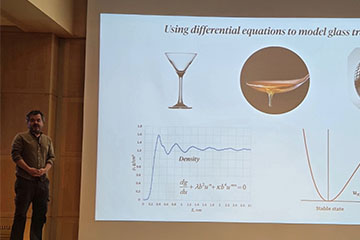Update on CMU’s Strategic Plan
University-wide efforts yield progress on all four priorities
As 2024 draws to a close, Central Michigan University is providing updates on the progress made on its 2023-2028 Strategic Plan. The plan, approved by the CMU Board of Trustees in September 2023, outlined four priorities to move the university forward:
- Priority One: Inspire student and scholarly success – Prepare bold leaders and learners who innovate and adapt in a rapidly changing world.
- Priority Two: Engage communities – Cultivate and enrich reciprocal partnerships with university stakeholders to ensure a lasting impact in the communities we serve.
- Priority Three: Enhance organizational culture – Raise our national profile as a vibrant and nurturing university community where all members feel valued, empowered to thrive, and experience a strong sense of belonging.
- Priority Four: Ensure institutional sustainability – Embrace sustainable campus operations that ensure wise stewardship of our resources.
“As we continue to build on CMU’s progress, this plan, with its clear, measurable goals, will be vital to our success,” said CMU President Neil MacKinnon. “The priorities we have outlined in the plan will lead to significant positive outcomes for all university stakeholders, with direct impact on our students and the communities we serve.”
Each of the four priorities includes a set of goals and measures that guide the university’s efforts. Since the plan’s approval, multiple working groups have been tasked with driving progress on each of the priorities and goals.
“We are working across all divisions toward what is best for the university as a whole,” said Joe Garrison, university budget officer and assistant to the university president for strategic initiatives. “There has been remarkable synergy between and among people from different divisions as they talk about what does and doesn’t work and what steps we can take to grow and improve.”
Exciting achievements
Garrison said working groups made substantial progress on several plan goals in 2024. For example, Garrison noted that priority one included a goal to reach a 95% career outcomes rate among CMU’s undergraduate students by 2028. In 2024, CMU announced a 94.9% successful career outcomes rate – just one-tenth of one percentage point away from its overall goal.
Other successes include:
- Record-breaking research-related funding, which aligns with priority one’s goal to strategically grow CMU’s research and graduate enterprise.
- Opening the CMU Innovation and Online and Rural Health Equity Institute’s Traverse City location and increasing partnerships with rural and underserved communities, aligning with priority two’s goal of developing strategies and enhancing relationships to meet the needs of communities throughout Michigan.
- The launch of a new pilot program for dialogic training for students and multiple dialogue workshops for faculty and staff, aligning with priority three’s goal to promote programs that improve dialogue and discourse, especially around polarizing topics.
- The largest-ever fundraising year in CMU history, aligning with priority four’s goal of ensuring institutional sustainability.
- Reinstituting the CMU Staff Excellence Award program and recognizing 17 individuals in 2024.
“Prioritizing efforts that will positively impact students, such as immersive learning experiences and student retention, is a primary focus of our work,” Garrison said. “At the same time, important values such as inclusivity and sustainability are incorporated into the plan priorities. We’re making progress on all of these vital goals.”
Exceeding KPIs
As part of the strategic planning process, CMU leaders identified a set of key performance indicators (KPIs) critical to the overall success of the institution, Garrison said. These are operational measures and assessments that speak to the health of CMU and that serve as a foundation for all the other work toward plan priorities, he said.
The KPIs are grouped into four categories:
- Enrollment, which includes several headcounts for student populations, market share comparisons, and retention rates.
- Financial, which includes CMU’s composite financial index and discount rate.
- Institutional, including philanthropic support, research funding, earned media, and social media reporting, and staff retention.
- Key benchmarks, which include CMU’s faculty-to-student ratio and the total-employee-to-student ratio.
Garrison said that KPIs in nearly every category met or exceeded expectations. This included increases in first-time-in-any-college, transfer and international student enrollments and first-to-second-year retention rates; record-breaking research funding and philanthropic giving; increased earned media averages; and outstanding ratings for CMU’s financial health.
As CMU completes parts of the plan, and as the landscape of higher education changes, the strategic planning team will review and adapt KPIs as needed, Garrison said.
Challenges and opportunities in 2024
One of the most significant challenges identified by working groups this year was technology, Garrison said. Several of the goals require CMU to implement new or adapt existing systems to improve data gathering and assessment.
“Many of the systems in place now gather and store a wide range of information but merging that data to gain insights from it is not currently possible,” he said. “As an institution, we need to mine and share our data better across departments and divisions to inform decision-making.”
In academic year 2023-2024, CMU was concurrently developing multiple plans to address important aspects of university life and operations, including the Academic Vision and Plan and the Diversity, Equity, Inclusion, Justice and Belonging Strategic Plan. CMU also began preparations for its Higher Learning Commission re-accreditation process.
“Engaging in these critical initiatives concurrently created an opportunity to align our work in meaningful ways,” Garrison said. “Building and implementing these plans and processes at the same time allowed us to locate and strengthen common goals and objectives.”
Living the brand
Among 2024’s challenges was a lack of resources, both financial and personnel, Garrison said. Multiple years of budget reductions and reallocations have impacted growth in some areas, and individuals tasked with working on the plan often have many other responsibilities.
Yet, progress is happening. Garrison noted that many of the working groups began to work collaboratively across priorities to identify shared opportunities and that there was broader communication between and among divisions to coordinate efforts. That determined teamwork exemplifies the university's We do brand, Garrison said.
“I am truly proud of and energized by the work already underway and by the work still ahead of us,” President MacKinnon said. “We’ve made good headway in the first year, but there’s a great deal of work still to do. There are exciting ways for every member of our community to participate in the plan’s goals, and we will need everyone to engage to achieve our priorities.”




